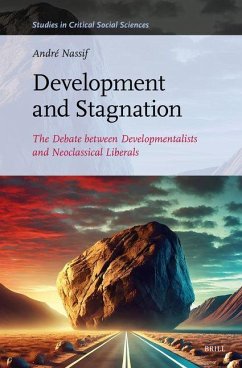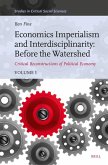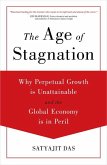André Nassif
Development and Stagnation
The Debate Between Developmentalists and Neoclassical Liberals
André Nassif
Development and Stagnation
The Debate Between Developmentalists and Neoclassical Liberals
- Gebundenes Buch
- Merkliste
- Auf die Merkliste
- Bewerten Bewerten
- Teilen
- Produkt teilen
- Produkterinnerung
- Produkterinnerung
This book presents the theoretical debate on economic development and stagnation in a clear and organized manner. It examines the complexity of economic theory, shaped by the interactions of diverse agents--firms, households, governments, and banks--across various markets. Despite its abstract nature, economic theories can be made accessible through careful explanation. Here, André Nassif covers the main theoretical foundations of economic development, incorporating key contributions from Latin America, offering a comprehensive overview that critically engages with these theories while maintaining academic rigor.…mehr
Andere Kunden interessierten sich auch für
![In and Against Development: From New to Newest Development Economics In and Against Development: From New to Newest Development Economics]() Benjamin FineIn and Against Development: From New to Newest Development Economics115,99 €
Benjamin FineIn and Against Development: From New to Newest Development Economics115,99 €![Dynamics of China's Economy Dynamics of China's Economy]() Zhiming LongDynamics of China's Economy147,99 €
Zhiming LongDynamics of China's Economy147,99 €![Economics Imperialism and Interdisciplinarity: Before the Watershed Economics Imperialism and Interdisciplinarity: Before the Watershed]() Benjamin FineEconomics Imperialism and Interdisciplinarity: Before the Watershed151,99 €
Benjamin FineEconomics Imperialism and Interdisciplinarity: Before the Watershed151,99 €![Crisis, Inequalities and Poverty Crisis, Inequalities and Poverty]() Francesco SchettinoCrisis, Inequalities and Poverty139,99 €
Francesco SchettinoCrisis, Inequalities and Poverty139,99 €![Class, Capital, State, and Late Development Class, Capital, State, and Late Development]() Gönenç UysalClass, Capital, State, and Late Development150,99 €
Gönenç UysalClass, Capital, State, and Late Development150,99 €![The Age of Stagnation The Age of Stagnation]() Satyajit DasThe Age of Stagnation25,99 €
Satyajit DasThe Age of Stagnation25,99 €![A Contribution to the Critique of Political Economy A Contribution to the Critique of Political Economy]() Karl MarxA Contribution to the Critique of Political Economy30,99 €
Karl MarxA Contribution to the Critique of Political Economy30,99 €-
-
-
This book presents the theoretical debate on economic development and stagnation in a clear and organized manner. It examines the complexity of economic theory, shaped by the interactions of diverse agents--firms, households, governments, and banks--across various markets. Despite its abstract nature, economic theories can be made accessible through careful explanation. Here, André Nassif covers the main theoretical foundations of economic development, incorporating key contributions from Latin America, offering a comprehensive overview that critically engages with these theories while maintaining academic rigor.
Produktdetails
- Produktdetails
- Verlag: Brill
- Seitenzahl: 316
- Erscheinungstermin: 31. Juli 2025
- Englisch
- Abmessung: 239mm x 155mm x 23mm
- Gewicht: 576g
- ISBN-13: 9789004734289
- ISBN-10: 9004734287
- Artikelnr.: 73400501
- Herstellerkennzeichnung
- Libri GmbH
- Europaallee 1
- 36244 Bad Hersfeld
- gpsr@libri.de
- Verlag: Brill
- Seitenzahl: 316
- Erscheinungstermin: 31. Juli 2025
- Englisch
- Abmessung: 239mm x 155mm x 23mm
- Gewicht: 576g
- ISBN-13: 9789004734289
- ISBN-10: 9004734287
- Artikelnr.: 73400501
- Herstellerkennzeichnung
- Libri GmbH
- Europaallee 1
- 36244 Bad Hersfeld
- gpsr@libri.de
Foreword
Luiz Carlos Bresser-Pereira
Preface
Figures and Tables
Introduction
Economic Development and Stagnation: the Different Theoretical Views
An Illustrative Case: Brazil from Economic Development to Stagnation
What to Expect from This Book
Organisation of the Book
Part 1: The Developmental School
Prologue to Part 1
1 The Conceptual Roots of Developmentalism
1 Introduction
2 Smith and Increasing Returns
3 Marx and Capital Accumulation
4 Schumpeter and Technological Progress as a Process of “Creative
Destruction”
5 Conclusion
2 Classical Developmentalism and Its Recent Unfoldings
1 Introduction
2 Economic Development as Structural Change: the Lewis Model with
Unlimited Labour Supply
3 The Big Push Model and Development as a Balanced Process
4 Production Linkages and Development as an Unbalanced Process
5 Industrialisation, Deindustrialisation and Stagnation
6 Conclusion
3 The Centre-Periphery Model and eclac’s Political Economy: Yesterday and
Today
1 Introduction
2 The Centre-Periphery Model as a Theoretical Basis for Latin American
Developmental Structuralism
3 eclac’s Political Economy and the Developmental State
4 eclac’s Neostructuralism and the Centre-Periphery Model Today
5 Conclusion
4 Underdevelopment, Development, and Stagnation: Celso Furtado’s
Theoretical Relevance
1 Introduction
2 Underdevelopment, Development and Stagnation under Furtado’s View
3 The Dutch Disease and the Resource Curse: Furtado’s Seminal Analysis
4 Conclusion
5 Prologue to New Developmentalism: Notes on the Inflation Targeting Regime
and Fiscal Austerity
1 Introduction
2 Inflation Targeting Regime
3 Fiscal Austerity
4 Conclusion
6 New Developmentalism: Integrating Macroeconomics with Development Theory
1 Introduction
2 The Central Theses of New Developmentalism
3 Critical Points of the New Developmental Theory
4 Conclusion
7 Conclusion and Policy Implications of Part 1: in Defence of the Return of
National Development Plans
Part 2: The Neoclassical Liberal School
Prologue to Part 2
8 International Trade Theories and the Case for Free Trade
1 Introduction
2 New International Trade Theories and the Reaffirmation of Free Trade
3 Conclusion
9 The Neoclassical Macroeconomics of Growth
1 Introduction
2 Growth Models in Closed Economies
3 Neoclassical Growth Models in Open Economies
4 Neoclassical Growth Models: the Developmental Critique
5 Conclusion
10 The Washington Consensus and the Ideology of Neoliberalism
1 Introduction
2 The Bretton Woods Era and Regulated Liberalism
3 The Washington Consensus and the Spread of Neoliberalism
4 Conclusion
11 Conclusion and Policy Implications of Part 2: Market Failures as a
Criterion for Adopting Public Policies
A Critical Evaluation of the Neoclassical Liberal Argument
1 Market Failures as a Criterion for Adopting Public Policies: the
Neoclassical Liberal Argument
2 Market Failures: a Critique of the Neoclassical Liberal Argument
Conclusion
Bibliography
Index
Luiz Carlos Bresser-Pereira
Preface
Figures and Tables
Introduction
Economic Development and Stagnation: the Different Theoretical Views
An Illustrative Case: Brazil from Economic Development to Stagnation
What to Expect from This Book
Organisation of the Book
Part 1: The Developmental School
Prologue to Part 1
1 The Conceptual Roots of Developmentalism
1 Introduction
2 Smith and Increasing Returns
3 Marx and Capital Accumulation
4 Schumpeter and Technological Progress as a Process of “Creative
Destruction”
5 Conclusion
2 Classical Developmentalism and Its Recent Unfoldings
1 Introduction
2 Economic Development as Structural Change: the Lewis Model with
Unlimited Labour Supply
3 The Big Push Model and Development as a Balanced Process
4 Production Linkages and Development as an Unbalanced Process
5 Industrialisation, Deindustrialisation and Stagnation
6 Conclusion
3 The Centre-Periphery Model and eclac’s Political Economy: Yesterday and
Today
1 Introduction
2 The Centre-Periphery Model as a Theoretical Basis for Latin American
Developmental Structuralism
3 eclac’s Political Economy and the Developmental State
4 eclac’s Neostructuralism and the Centre-Periphery Model Today
5 Conclusion
4 Underdevelopment, Development, and Stagnation: Celso Furtado’s
Theoretical Relevance
1 Introduction
2 Underdevelopment, Development and Stagnation under Furtado’s View
3 The Dutch Disease and the Resource Curse: Furtado’s Seminal Analysis
4 Conclusion
5 Prologue to New Developmentalism: Notes on the Inflation Targeting Regime
and Fiscal Austerity
1 Introduction
2 Inflation Targeting Regime
3 Fiscal Austerity
4 Conclusion
6 New Developmentalism: Integrating Macroeconomics with Development Theory
1 Introduction
2 The Central Theses of New Developmentalism
3 Critical Points of the New Developmental Theory
4 Conclusion
7 Conclusion and Policy Implications of Part 1: in Defence of the Return of
National Development Plans
Part 2: The Neoclassical Liberal School
Prologue to Part 2
8 International Trade Theories and the Case for Free Trade
1 Introduction
2 New International Trade Theories and the Reaffirmation of Free Trade
3 Conclusion
9 The Neoclassical Macroeconomics of Growth
1 Introduction
2 Growth Models in Closed Economies
3 Neoclassical Growth Models in Open Economies
4 Neoclassical Growth Models: the Developmental Critique
5 Conclusion
10 The Washington Consensus and the Ideology of Neoliberalism
1 Introduction
2 The Bretton Woods Era and Regulated Liberalism
3 The Washington Consensus and the Spread of Neoliberalism
4 Conclusion
11 Conclusion and Policy Implications of Part 2: Market Failures as a
Criterion for Adopting Public Policies
A Critical Evaluation of the Neoclassical Liberal Argument
1 Market Failures as a Criterion for Adopting Public Policies: the
Neoclassical Liberal Argument
2 Market Failures: a Critique of the Neoclassical Liberal Argument
Conclusion
Bibliography
Index
Foreword
Luiz Carlos Bresser-Pereira
Preface
Figures and Tables
Introduction
Economic Development and Stagnation: the Different Theoretical Views
An Illustrative Case: Brazil from Economic Development to Stagnation
What to Expect from This Book
Organisation of the Book
Part 1: The Developmental School
Prologue to Part 1
1 The Conceptual Roots of Developmentalism
1 Introduction
2 Smith and Increasing Returns
3 Marx and Capital Accumulation
4 Schumpeter and Technological Progress as a Process of “Creative
Destruction”
5 Conclusion
2 Classical Developmentalism and Its Recent Unfoldings
1 Introduction
2 Economic Development as Structural Change: the Lewis Model with
Unlimited Labour Supply
3 The Big Push Model and Development as a Balanced Process
4 Production Linkages and Development as an Unbalanced Process
5 Industrialisation, Deindustrialisation and Stagnation
6 Conclusion
3 The Centre-Periphery Model and eclac’s Political Economy: Yesterday and
Today
1 Introduction
2 The Centre-Periphery Model as a Theoretical Basis for Latin American
Developmental Structuralism
3 eclac’s Political Economy and the Developmental State
4 eclac’s Neostructuralism and the Centre-Periphery Model Today
5 Conclusion
4 Underdevelopment, Development, and Stagnation: Celso Furtado’s
Theoretical Relevance
1 Introduction
2 Underdevelopment, Development and Stagnation under Furtado’s View
3 The Dutch Disease and the Resource Curse: Furtado’s Seminal Analysis
4 Conclusion
5 Prologue to New Developmentalism: Notes on the Inflation Targeting Regime
and Fiscal Austerity
1 Introduction
2 Inflation Targeting Regime
3 Fiscal Austerity
4 Conclusion
6 New Developmentalism: Integrating Macroeconomics with Development Theory
1 Introduction
2 The Central Theses of New Developmentalism
3 Critical Points of the New Developmental Theory
4 Conclusion
7 Conclusion and Policy Implications of Part 1: in Defence of the Return of
National Development Plans
Part 2: The Neoclassical Liberal School
Prologue to Part 2
8 International Trade Theories and the Case for Free Trade
1 Introduction
2 New International Trade Theories and the Reaffirmation of Free Trade
3 Conclusion
9 The Neoclassical Macroeconomics of Growth
1 Introduction
2 Growth Models in Closed Economies
3 Neoclassical Growth Models in Open Economies
4 Neoclassical Growth Models: the Developmental Critique
5 Conclusion
10 The Washington Consensus and the Ideology of Neoliberalism
1 Introduction
2 The Bretton Woods Era and Regulated Liberalism
3 The Washington Consensus and the Spread of Neoliberalism
4 Conclusion
11 Conclusion and Policy Implications of Part 2: Market Failures as a
Criterion for Adopting Public Policies
A Critical Evaluation of the Neoclassical Liberal Argument
1 Market Failures as a Criterion for Adopting Public Policies: the
Neoclassical Liberal Argument
2 Market Failures: a Critique of the Neoclassical Liberal Argument
Conclusion
Bibliography
Index
Luiz Carlos Bresser-Pereira
Preface
Figures and Tables
Introduction
Economic Development and Stagnation: the Different Theoretical Views
An Illustrative Case: Brazil from Economic Development to Stagnation
What to Expect from This Book
Organisation of the Book
Part 1: The Developmental School
Prologue to Part 1
1 The Conceptual Roots of Developmentalism
1 Introduction
2 Smith and Increasing Returns
3 Marx and Capital Accumulation
4 Schumpeter and Technological Progress as a Process of “Creative
Destruction”
5 Conclusion
2 Classical Developmentalism and Its Recent Unfoldings
1 Introduction
2 Economic Development as Structural Change: the Lewis Model with
Unlimited Labour Supply
3 The Big Push Model and Development as a Balanced Process
4 Production Linkages and Development as an Unbalanced Process
5 Industrialisation, Deindustrialisation and Stagnation
6 Conclusion
3 The Centre-Periphery Model and eclac’s Political Economy: Yesterday and
Today
1 Introduction
2 The Centre-Periphery Model as a Theoretical Basis for Latin American
Developmental Structuralism
3 eclac’s Political Economy and the Developmental State
4 eclac’s Neostructuralism and the Centre-Periphery Model Today
5 Conclusion
4 Underdevelopment, Development, and Stagnation: Celso Furtado’s
Theoretical Relevance
1 Introduction
2 Underdevelopment, Development and Stagnation under Furtado’s View
3 The Dutch Disease and the Resource Curse: Furtado’s Seminal Analysis
4 Conclusion
5 Prologue to New Developmentalism: Notes on the Inflation Targeting Regime
and Fiscal Austerity
1 Introduction
2 Inflation Targeting Regime
3 Fiscal Austerity
4 Conclusion
6 New Developmentalism: Integrating Macroeconomics with Development Theory
1 Introduction
2 The Central Theses of New Developmentalism
3 Critical Points of the New Developmental Theory
4 Conclusion
7 Conclusion and Policy Implications of Part 1: in Defence of the Return of
National Development Plans
Part 2: The Neoclassical Liberal School
Prologue to Part 2
8 International Trade Theories and the Case for Free Trade
1 Introduction
2 New International Trade Theories and the Reaffirmation of Free Trade
3 Conclusion
9 The Neoclassical Macroeconomics of Growth
1 Introduction
2 Growth Models in Closed Economies
3 Neoclassical Growth Models in Open Economies
4 Neoclassical Growth Models: the Developmental Critique
5 Conclusion
10 The Washington Consensus and the Ideology of Neoliberalism
1 Introduction
2 The Bretton Woods Era and Regulated Liberalism
3 The Washington Consensus and the Spread of Neoliberalism
4 Conclusion
11 Conclusion and Policy Implications of Part 2: Market Failures as a
Criterion for Adopting Public Policies
A Critical Evaluation of the Neoclassical Liberal Argument
1 Market Failures as a Criterion for Adopting Public Policies: the
Neoclassical Liberal Argument
2 Market Failures: a Critique of the Neoclassical Liberal Argument
Conclusion
Bibliography
Index








